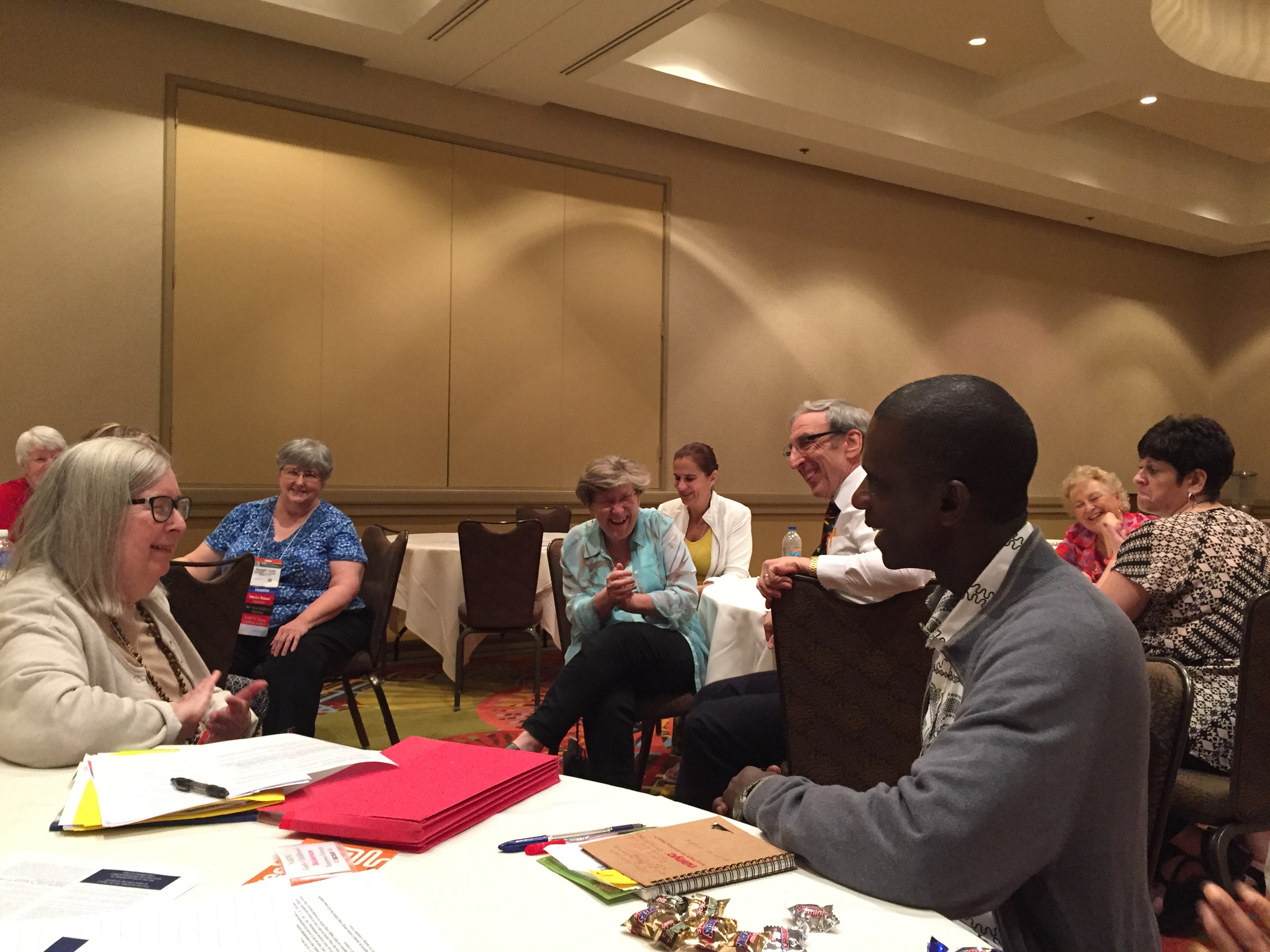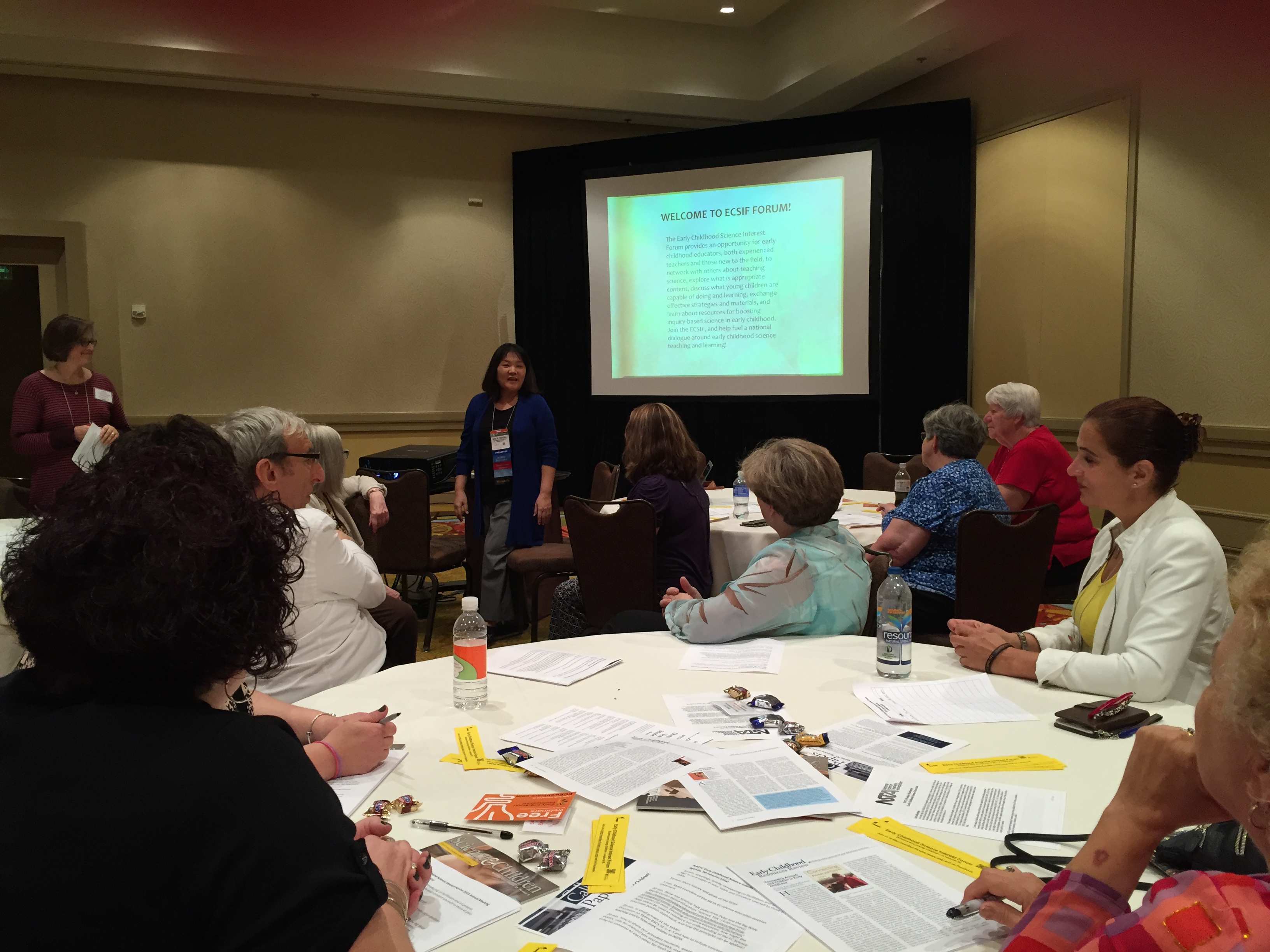Science & Engineering Sessions at NAEYC 2015
By Peggy Ashbrook
Posted on 2015-11-29
Science inquiry, engineering design, research-based practices, the NSTA position statement on Early Childhood Science Education, and the Next Generation Science Standards were all part of presentations I attended at the conference of the National Association for the Education of Young Children. Presenters shared the science and engineering work done by the children in their programs, the connections they made with families, and the research they conducted about early science and engineering learning.
 The NAEYC Early Childhood Science Interest Forum (ECSIF) held the annual discussion and meeting at the NAEYC annual conference. Although all members are not able to attend, we try to stay connected through Facebook, the ECSIF blog, and the NAEYC Interest Forum pages. Add your voice and experiences to the group—join as an NAEYC member or simply follow the group on social media.
The NAEYC Early Childhood Science Interest Forum (ECSIF) held the annual discussion and meeting at the NAEYC annual conference. Although all members are not able to attend, we try to stay connected through Facebook, the ECSIF blog, and the NAEYC Interest Forum pages. Add your voice and experiences to the group—join as an NAEYC member or simply follow the group on social media.
Here is a list of some of the 2015 sessions related to science, engineering and environmental education—I could not attend all of them! They are listed in the order they occurred at the conference. Look up additional information on the NAEYC conference session planner before it closes, or the conference program.
Tell us about your session in a comment below!
|
Presentation title |
Presenter |
Topic track category |
|
National Organization for |
Mary Bowne, Ethan and Ron King, Kay Cutler |
Environmental Education for Children |
|
Ramps and pathways: A fun integration of science, technology, engineering, and mathematics |
Beth Van Meeteren, Peggy Ashbrook |
Science |
|
Beyond alphabet soup – STEM and the arts: Encouraging child-centered investigations in mathematics and science through arts integration |
Eugene Geist, Kamile Geist |
Music |
|
Science stories: Connecting science and dramatic play in your classroom |
Miriam Krause, Janna Doherty |
Science |
|
Inspiring lessons from nature: Supporting children’s social and emotional development in nature-rich indoor and outdoor environments |
Julie Rose, Sandra Duncan |
Social/Emotional Development |
|
Integrating math standards into early childhood science lessons |
Winnifred Namatovu, Lindsey Haubert |
Teaching & Instructional Practices |
|
Nature nurtures: How being outdoors with infants and toddlers supports whole-child learning and enhances teacher job satisfaction |
Heather Fox, Christine Kiewra |
Physical Development |
|
Buzz, bubble, and bounce: Everyday STEM activities for infants and toddlers |
Jean Barbre |
Science |
|
Can you build it? Engineering design challenge in the kindergarten classroom |
Erica Green |
Science |
|
Supporting STEM learning in the early years: Using nature connections to strengthen foundational understandings in science, technology, engineering, and math |
Susan Wirth, Heather Fox |
Science |
|
Cabinets of curiosity: Exploring the “Ologies” with elementary-aged students through the art of collections |
Ilana April, Natalie Tahsler |
Science |
|
Engineering: Using STEM to apply academics to real world solutions |
Janelle Pauldine, Jen Lintner |
Child Development & Learning |
|
Integration of science and music through science song contest |
Jiyoon Yoon, Kyoungjin Kim |
Science |
|
From STEM to STEAM: What we can learn from Fred Rogers and how we can apply his approach to our work with children |
Hedda Sharapan |
Science |
|
The development of a research project with children in nature: Our journey over a three-year span |
Jacquelyn Weller, Margaret Desormes |
Teaching & Instructional Practices |
|
Nurturing scientific curiosity through exploration and discovery: Selecting materials and strategies that cultivate scientific skills and knowledge |
Bonnie Ripstein, Leslie Sevey |
Science |
|
Overcoming fears and challenges of incorporating STEM in pre-K: Lessons learned from a curriculum development-school district partnership initiative |
Elizabeth Bell, Kylie Howard, Ashley Mathis, Mary Konrad |
Science |
|
Loose parts to promote STEAM (Science, Technology, Engineering, Art and Math) concepts |
Miriam Beloglovsky, Lisa Daly |
Play |
|
Science, technology, and engineering experiences with living and non-living objects: Exploring the concept of change over time though the eyes of preschool dual language learners |
Betty Zan, Suzane Croteau, Heidi Chait, Tracy Wang, Kimberly Brenneman, Daryl Greenfield |
Science |
|
Bringing the inside out: Using class trips to promote young learners’ scientific literacy |
Caitlin Coe, Ilana April, Natalie Tahsler |
Science |
|
Nature and the outdoors for all young children: Tools and resources for advocating for environmental education |
Christy Merrick, Allen Cooper |
Advocacy/Public Policy |
|
Early childhood preservice teachers’ self-efficacy beliefs about equitable science teaching |
Eun Young Lee, Karthigeyan Subramaniam, Yilmin Koo |
Research |
|
Establishing the roots of science: Implementing a developmentally-appropriate, inquiry-based approach to science in the preschool classroom |
Bailey Choi |
Research |
|
Nurturing through nature: How to establish a wildlife habitat with young |
Jill Raisor, Yajuan Xiang, Jennifer Mohr |
Research |
|
Preservice teachers’ sense of efficacy in teaching early childhood science |
Jill Jacobi-Vessels |
Research |
|
Teachers’ receptivity toward adopting evidence-based practices and the Classroom Assessment Scoring System (CLASS) and preferred interventions to improve instructional practices |
Teresa Oster, Andrea McDonnell, Catherine Nelson |
Research |
|
100 languages of nature through the voices of children: How to create playscapes that foster learning environments |
Miriam Melamed-Turkish |
Environmental Education for Children |
|
Examining kindergarten teachers’ beliefs and practices in science education |
Hye In Jeong |
Science |
|
The playground’s impact on children’s play behaviors: Does a nature-scape playground make a difference in how children play? |
Neil Mecham, Tiffany Hurtt |
Research |
|
Full S.T.E.A.M. ahead! Brain appropriate practices for children learning Science, Technology, Engineering, Arts, and Math |
Regina Lamourelle, Chantal Lamourelle, Elizabeth Stephens |
Curriculum–Theories & Approaches |
|
Toddlers, problem solving, and creativity: Thinking IN and OUT of the box! |
Rosemary Geiken, Jill Uhlenberg, Akiko (Sonia) Yoshizawa |
Science |
|
Supporting learning for dual language learners and all children: Incorporating language into early science and math learning experiences using research-based, developmentally appropriate strategies and activities |
Kimberly Brenneman, Alissa Lange |
Science |
|
The art of learning: Using arts and crafts to explore math, science, literacy, and social-emotional development |
Cathy Crawford |
Child Development & Learning |
Disclaimer: The views expressed in this blog post are those of the author(s) and do not necessarily reflect the official position of the National Science Teaching Association (NSTA).




